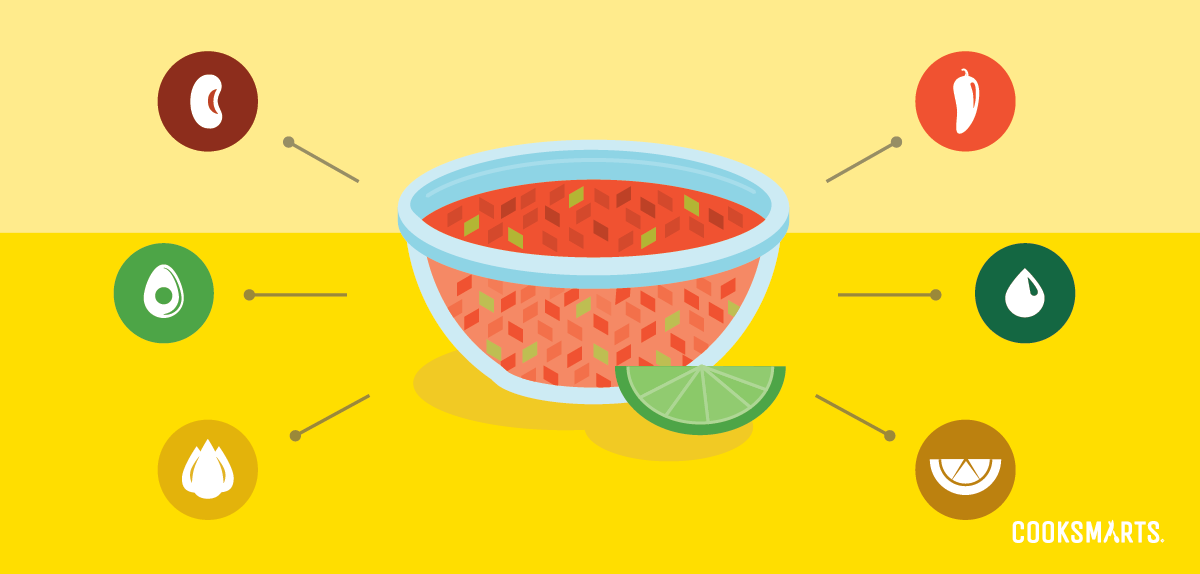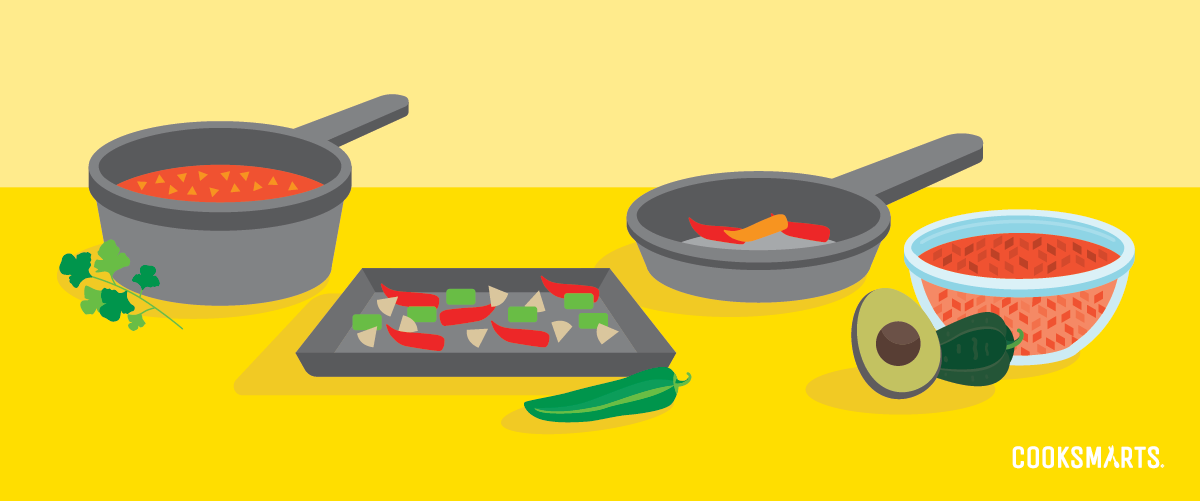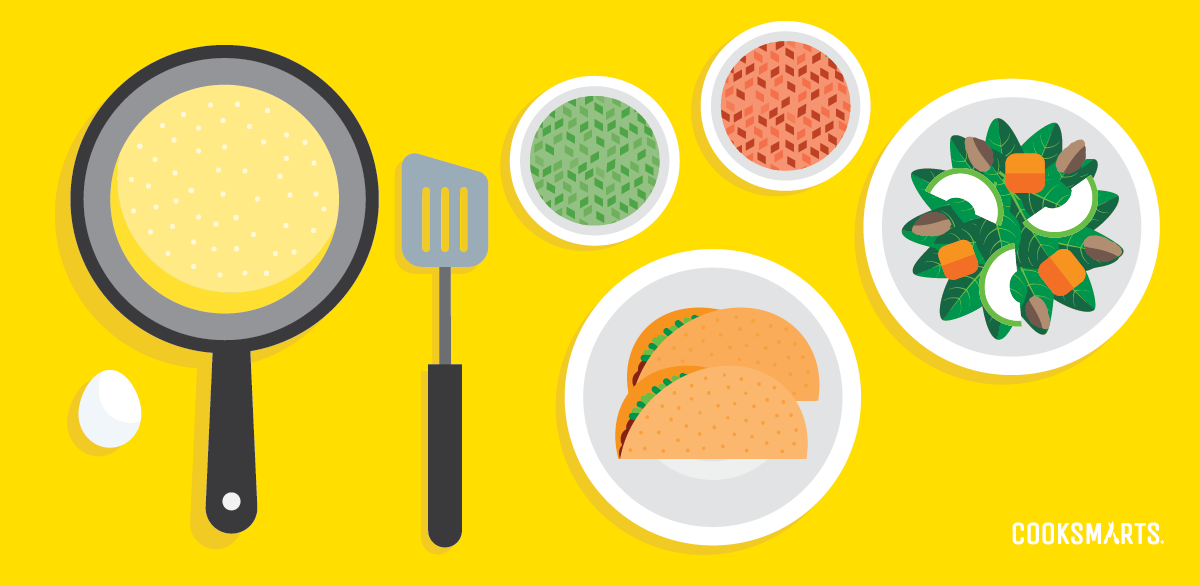Peppers, Salsas, and How to Use Them (New Infographic Guide!)
Adding a burst of flavor has never been so easy. Let our infographic guide to homemade salsa recipes spice up your mealtimes!
Peppers and salsas come in all colors, sizes, and heats. Biting into the right pepper can leave you reaching for another spoonful or running towards the nearest glass of milk. In this article, we’ll guide you through the origins of salsa, the many types of peppers, and how to craft a perfect salsa for your palate.
Salsa technically means “sauce” in Spanish and has been livening up Latin American food for centuries. What many people don’t know is that the history of salsa actually starts with the Aztecs, Mayans, and Incas. Spanish writings reported that Aztecs made a sauce combining chilies, tomatoes, spices, and ingredients like squash seeds and beans. So, we can thank indigenous people groups for every spoonful of fresh and exciting flavor!
Enjoy our free downloadable infographic that will walk you through pepper and salsa basics:
Peppers and Salsas Cooking Guide

Learn about a variety of peppers and how to turn them into salsas, so that you can add a burst of fresh flavor to your homemade meals.
Discover More Flavor
Let us guide you through a variety of peppers and salsas to give your meals a fresh burst of flavor.
I acknowledge by requesting this info, I'll be added to Cook Smarts' newsletter list. I can unsubscribe at any time.
Peppers: Flavor and Heat
If you do an internet search for a type of pepper, you will keep seeing “SHU” pop up in descriptions. But what is SHU? The acronym stands for Scoville Heat Units, a mode of measurement for the spicy heat pungency on the Scoville scale. At a glance, this scale can help you understand which is a sweet pepper, which is a hot pepper, and which is the hottest pepper in the world.
Here are some chilis commonly used in salsas:
Fresh Peppers
- Bell peppers – sweet with no heat (0 – 100 SHU)
- Anaheims – slightly sweet, spicy, or smoky with mild heat (500 – 2,500 SHU)
- Poblanos – earthy and smoky with mild heat (1,000 – 2,000 SHU)
- Jalapeños – green jalapenos are grassy and crisp, while red ones are sweet and fruity; both contain mild to strong heat (2,500 – 11,000 SHU)
- Serranos – clean and crisp with a potent heat (6,000 – 25,000 SHU)
- Thai chilies – spicy and slightly fruity with extreme heat (50,000 – 100,000 SHU)
- Habaneros – citrus-like with extreme heat (100,000 – 350,000 SHU)
- Carolina reapers – sweet and fruity with the most extreme heat of any pepper on earth (2 million + SHU)
Dried Peppers
- Anchos – sweet, smoky, and earthy with mild heat (1,000 – 1,500 SHU)
- Guajillo – sweet, tangy, crisp, and smoky with mild to medium heat (2,500 – 5,000 SHU)
- Chipotle – bold, smoky, and earthy with medium to medium-hot heat (2,500 – 8,000 SHU)

Simple Formula to Build Your Own Salsa
Your days of asking, “How do I make a simple homemade salsa?” are over. While pages and pages of salsa recipes are just a Google search away, we want to equip you with the skills to make your own salsa from scratch anytime, anywhere.
With our easy formula, you can mix and match any ingredients and create a variety of salsas catered exactly to your liking. Let your creativity run wild! The cooking formula consists of the following ingredients:
1. Peppers
Peppers add unique spice and flavor, depending on which pepper you use. From sweet and fruity to smoky and earthy, peppers add a distinct heat that differs from bottled hot sauces.
2. Aromatics
The foundation of any dish, these ingredients (like onions, shallots, and garlic) release addictive aromas and impart deep flavors to every salsa. Learn more about aromatics with our Guide to Aromatics.
3. Produce
Tomatoes or tomatillos create the common salsa base that we know and love. Meanwhile, other fruits and veggies (like corn, pineapple, mangos, and avocados) give a salsa an entirely unique personality, transforming a side sauce into a centerpiece.
4. Acids
Adding lime juice, lemon juice, or vinegar to your salsa can enhance and brighten its flavor. Whether you use a little for subtle hints or use more for a bold taste, acids can be the important ingredient that turns a good salsa into a great salsa.
5. Oils / Condiments
Oils smooth out a salsa and can give it just the right amount of healthy fat. Oils and other sauces (like fish sauce and soy sauce) can also give distinction to your salsa by adding a deep layer of flavor. Learn more about different kinds of oils and what they have to offer through our Guide to Oils.
6. Extras
Herbs and spices (like salt, cumin, and cilantro) give you the opportunity to bring all of your other salsa ingredients to life. Have fun being creative while still keeping some core authenticity! If you want to add substance and texture to your sauce, folding in canned beans or chopped nuts can add fun and protein-rich flare.
Cooking Formula for Salsas
Cooking formulas are what help you cook with ease and confidence. Instead of following recipes to a “t,” you can just remember the basic formula and use any ingredients, whether you find amazing seasonal produce in the market or if you’re looking to use up odds and ends in your fridge. You can even deviate a bit from cooking formulas to adjust flavors to your liking. If you like more garlic, add more garlic! If you prefer less heat, cut back on the amount of chili peppers. Here is our basic formula for making salsas:
- Peppers – 8 oz fresh or 4 oz dried
- Aromatics – 2 cloves garlic and 1/4 cup onions or 2 cloves shallot
- Produce – 2 cups
- Acids – 1 tablespoon or to taste
- Oils – 2 teaspoons
- Extras – Herbs and spices to taste and ½ cup of beans or ¼ cup of chopped nuts
If you aren’t comfortable going off book quite yet, our infographic above includes tried and true salsa ingredient combos. Once you’ve tried a few out, you’ll be building your own innovative salsa in no time!

4 Methods to Make Salsa
Now that you understand the basic formula of how to make a salsa, let’s get on with making your actual sauce! The following four methods yield different end results, all of which will keep your meals fresh and your mouth happy.
Stovetop Salsa
Making a cooked salsa on a stove top involves sautéing, boiling, and blending. Follow these steps:
- Chop aromatics, produce, and peppers (remove seeds for less heat).
- Saute aromatics in a pot, then add produce and peppers.
- Bring to a boil and simmer for 5 minutes to thicken.
- Blend in a blender or food processor with acids, oils, and condiments (if using).
- Season to taste and fold in extras (if using).
Broiled Salsa
Broiled or roasted salsas take a little longer, but have a more rich and earthy flavor. Follow these steps:
- Chop aromatics, produce, and peppers (remove seeds for less heat).
- Place ingredients on a sheet pan and toss with 1 tablespoon of cooking oil.
- Broil in oven for 10 to 15 minutes until lightly blackened.
- Blend in a blender or food processor with acids, oils, and condiments (if using).
- Season to taste and fold in extras (if using).
Raw Salsa
Fresh raw salsas are the quickest because they only involve slicing and dicing. Follow these steps:
- Chop aromatics, produce, and peppers (remove seeds for less heat).
- Combine ingredients in a mixing bowl (for chunky salsa) or blender (for smooth salsa) with any acids, oils, and condiments (if using).
- Season to taste and fold in extras (if using).
Dried Chili Salsa
Making a dried chili salsa requires toasting and soaking dried chilis, which can be done while the aromatics and produce are broiled before blending all ingredients. Follow these steps:
- Chop aromatics, produce, and peppers (remove seeds for less heat).
- Toast dried chilis in a cast iron or heavy frying pan until fragrant.
- Soak toasted chilis in hot water for 10 minutes.
- Place aromatics and produce on a sheet pan, toss with 1 tablespoon of cooking oil, and broil in oven for 10 to 15 minutes until lightly blackened.
- Blend in a blender or food processor with acids, oils, and condiments (if using).
- Season to taste and fold in extras (if using).
Here are some helpful video reminders on the best way to dice, chop, cube, mince, or roast the following ingredients you can use in salsa:
How to Chop and Dice Peppers
Learn how to chop and dice red peppers to use for sautes, stir-fries, salads, and more.
How to Dice Jalapenos
Jalapeños have great flavor and can add heat to anything. See how to easily dice them here.
How to Chop & Dice an Onion
Learning how to dice an onion correctly will save you so much time in the kitchen.
How to Dice Tomatoes
Diced tomatoes add so much freshness to salsas, salads, and pastas, and they're super easy to prep.
Prepping Smarts:
We have even more short and helpful prep tutorials in our video archives to help you make salsas quickly and efficiently, like How to Dice Poblanos, How to Mince or Crush Garlic, How to Dice Tomatillos, How to Cube Pineapple, How to Dice Mango, and How to Slice Peaches.

Ways to Enjoy Salsa
Now that you have learned how to make a variety of salsas, what should you eat them with? We’ve started you off with a list of ideas to bring an ordinary dish to the next level. To spark your imagination or simply enjoy a tried and true salsa model, look to the Salsa Combos section on our handy infographic.
Try pairing your salsa creation with these meals and snacks:
- Use as a dip for chips or crackers
- Use as a condiment in tacos or burritos
- Use as a topping for enchiladas and nachos
- Whisk into soups (like how we do in our favorite Chicken Noodle Soup recipe!)
- Add to a fresh green salad
- Stir into scrambled eggs
- Fold into frittatas and omelets
- Mix into guacamole
- Spread on grilled cheese sandwiches
- Toss with sauteed vegetables
- Top on salads as a flavorful dressing
- Mix with mayo as a dip for fries or artichokes
- Use a sweet fruit salsa to glaze over meat or desserts
Now that you know a little more about peppers and have a handy formula to make salsas from scratch, we hope you are excited to give it a whirl! Be sure to download our free infographic PDF to use as a resource every time a meal needs an extra burst of flavor:
Do you have a favorite salsa combo recipe you’d like to share? Let us know in the comments below!
As always, we create content that will help you live your best life in the kitchen. For more cooking know-how, sign up for our newsletter below, and we’ll help you raise your kitchen IQ and cook with confidence by sending you our best cooking tips, articles, and infographic guides.
![4 Ways to Make a Salsa [Infographic] | Cook Smarts](https://www.cooksmarts.com/wp-content/uploads/2018/05/Salsas_Breakout_4Ways_D2-01.png)
![Build Your Own Salsa Cooking Formula [Infographic] | Cook Smarts](https://www.cooksmarts.com/wp-content/uploads/2018/05/Salsas_Breakout_BuildYourOwn_D1-01.png)
![Salsa Combo Recipes [Infographic] | Cook Smarts](https://www.cooksmarts.com/wp-content/uploads/2018/05/Salsas_Breakout_Combos_D1-01.png)
![Guide to Peppers [Infographic] | Cook Smarts](https://www.cooksmarts.com/wp-content/uploads/2018/05/Salsas_Breakout_GuideToPeppers_D1-01.png)
